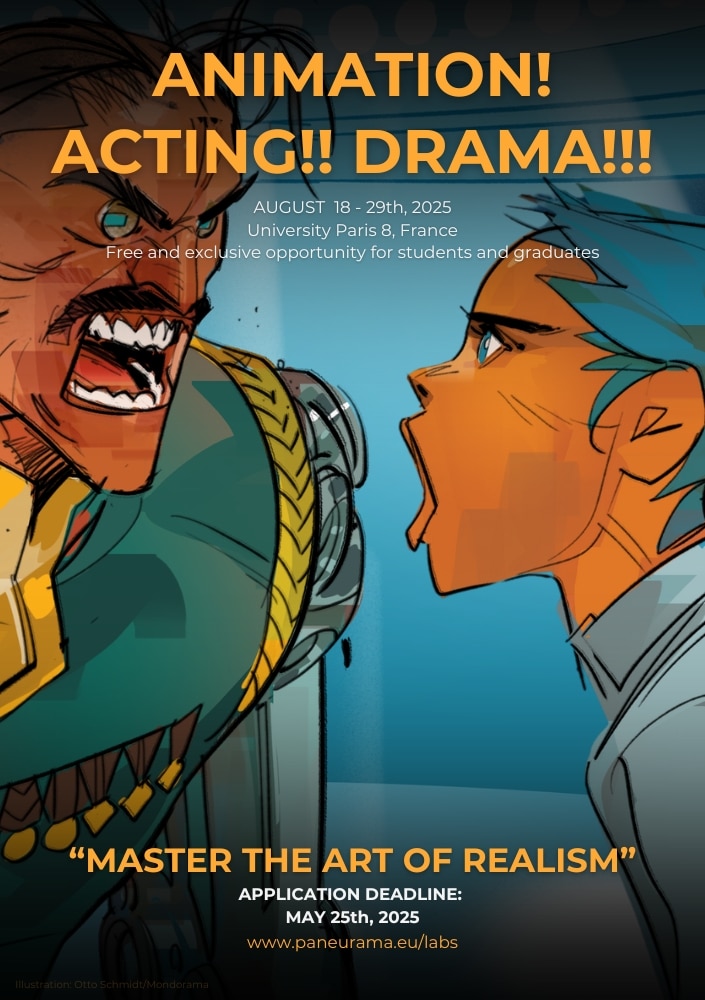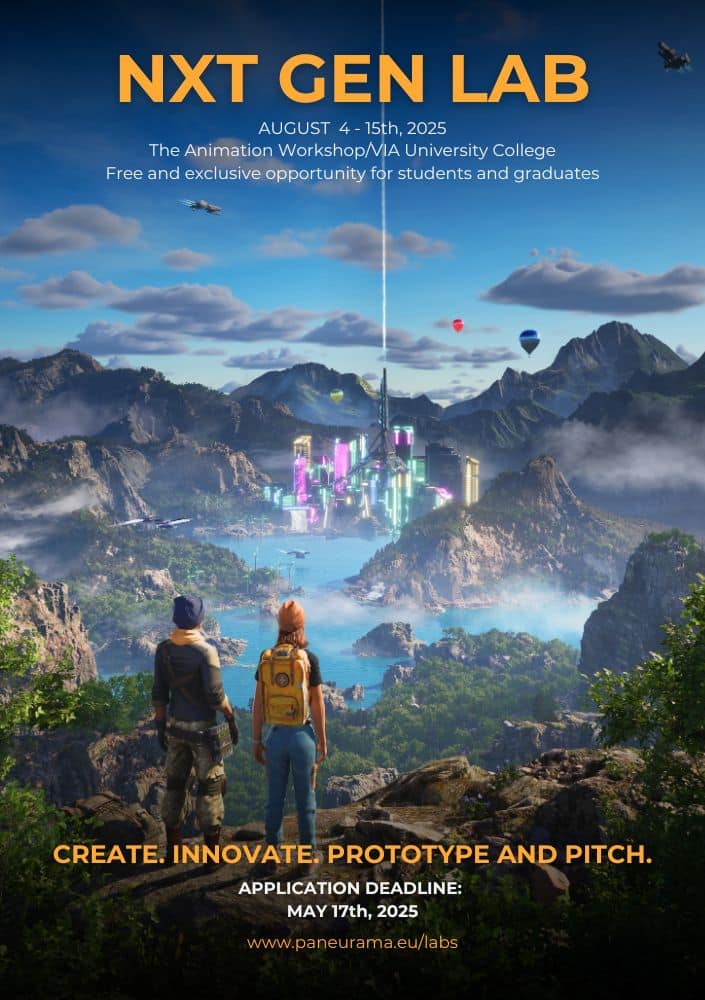We asked our team from the PANEURAMA project to briefly introduce themselves, share the areas they are working on, and respond to some questions addressing current challenges and opportunities in the industry.
We hope you will enjoy reading their insights. The interviewee is Morten Thorning from Creative Viborg.

Morten Thorning
Executive Consultant
@Creative Viborg
Q: Can you provide a brief overview of yourself, the industry you work in, and your professional experience?
From my early twenties, I worked as a scriptwriter, musician, and radio producer. I have been involved in animation since 1988, when I founded the Danish institution, The Animation Workshop (TAW). In its initial 15 years, TAW operated as an independent vocational training centre. In 2003, it became a part of VIA University College. For 31 years, until I started my own production company in 2020, I served as the head of TAW. This journey was driven by a vision to create a holistic institution, addressing various fields such as training, education, innovation, content development, European growth, skill development, and technological advancements — all related to the arts and craft of animation.
It was crucial to me that TAW functioned as an institution devoted to serving the global animation community and, in the best way possible, facilitating the personal growth of each individual student. I observed that many educational institutions often lack genuine responsibility for students’ personal development. They are more focused on meeting average management requirements than fulfilling their true purpose—to ensure that graduates, who invest some of their best years in education, can genuinely and individually find a place in the job market upon graduation. This perspective is particularly crucial for artistic and creative studies, which attract students with a strong imagination and a broader emotional range than other programs.
For the last four years, I have worked as a consultant, scriptwriter, and creative producer, engaging in a wide range of productions and strategic projects. I am a member of the artist group Plastic Collective, where I write scripts and produce short films, VR projects, and significant holographic projections.
Currently, I serve in PANEURAMA as a consultant, working for CREATIVE VIBORG. It functions as a hub and a hothouse, facilitating and housing new companies within the visual media.
Q: In recent years, what do you consider the most significant changes within your industry? How does it affect you or your company? Could you give some examples?
From the outset of TAW in 1988, we were still working with traditional animation techniques such as painting on cels. We had just begun a form of superimposed line testing on the Amiga computer, which, by the way, constantly crashed. Subsequently, computer-based colouring systems emerged, followed by the entire realm of digital 3D production. Eventually, games became the predominant market for animation, and we just witnessed a significant explosion in distribution platforms. Now we are facing a high-tech revolution in our production tools.
With each technological advancement, educational institutions have tried to adapt. Educations with strong ties and networks to companies in the market have been best at these transitions from low-cost art education with paper, pencils, and paint to establishing high-tech computer laboratories.
What we can glean from this is that while the market and technology may undergo changes, and the production methods may evolve, the creative content—the characters, stories, and the worlds they inhabit—cannot be solely generated by technology. It begins with a vision from individuals with a well-trained imagination. Subsequently, it is visualized by individuals possessing a variety of specialized skill sets. The actual production is carried out by collaborative teams with high artistic and technological skills.
As creatives, we need not fear emerging technologies but rather must master them and incorporate them into our toolkit. The fundamental skills of storytelling, imagination, drawing, and teamwork will always remain essential.
Q: What, in your opinion, are the primary challenges currently faced by the industry?
A rapidly changing distribution market can be challenging to navigate. It takes years to invent, pitch, plan finances, and produce animated films, TV series, and games. Companies must prepare their products for the market, often at least 2-3 years ahead of production. If explaining job security to your parents as an animator is difficult, imagine the challenge of convincing your bank to substantially extend your company’s credit (again).
On the one hand, European intellectual property (IP) still lacks massive global success, with some exceptions. On the other hand, production and financing are becoming increasingly global, which I view as a positive development. Let’s hope that the current unfavourable political climate will ease, creating space for a truly global film and TV market.
Changing technologies enable companies to produce faster and more efficiently, but they also pose the risk of investing in technologies that may become obsolete in a few years.
Companies must be capable of attracting and retaining a vast network of the right talent for their style and needs by offering a conducive work environment and declaring their ethics.
Q: Could you please identify the most significant opportunities within the industry?
For young talents aiming for a career in the visual arts, the industry is one of the most secure sectors to work in. The chance of earning a living, paid vacation, insurance, and even a retirement plan is not something offered to painters, fine artists, freelance illustrators, etc. Opportunities will open up for those who can imagine in large teams, work creatively with, and adapt to new technology that will continually change our workflow and possibilities.
Specifically, concerning animation, I believe that having basic 3D skills will secure job opportunities in gaming, VFX, and animation film/series. I would ensure that I can work as a generalist and have a couple of special skills that I truly master.
Finally, the ability to work online, in remotely organized teams, might not be what everybody desires socially. Still, it is a skill that can open up job opportunities, especially during periods in life when it is the best way to work for you—particularly in the years when your kids are small and require a lot of attention from you as a parent or if someone in the family gets sick and needs care while you have to make money at the same time.
Q: What do you think are the most important hard skills in your industry?
Drawing! Drawing! Drawing! Is that a hard or a soft skill?
Your ability to instantly visualize what is inside your imagination will always hold high value, both when developing, researching, and seeking, but also when communicating and reshaping your vision together with your team.
Scientifically, it is proven that while learning to draw, you are expanding your ability to imagine, see, and sense the universe around you. These are fundamental abilities if you aspire to work as a visual creator.
The ability of an animator to switch between both 2D and 3D will provide a broader range of job opportunities. Also, the ability to adapt to new software and new work methods, being a software-agnostic is important.
Q: What recommendations would you offer to educational institutions to foster closer collaboration with the industry? Could you share some examples?
Establish industry presence on boards and steering groups to assist with the institution’s strategy and curriculum planning.
Develop a broad network with dedicated companies in the industry.
Extend invitations to companies to assess the works, pitches, and portfolio presentations of the students.
Organize long-term internship periods at the conclusion of the educational program.
Debrief the students upon their return for their final exams.
Utilize professionals from the industry as teachers.
Ensure that the education program has the financial capability to employ a group of skilled tech/IT specialists who can consistently monitor development, and enhance gear, equipment, and software to align with innovations and changes in the industry.
Q: As an industry representative, what do you think companies should focus more on to better prepare young artists for their careers?
Refer to the previous answers; it’s a mutual relationship. Companies should seek out, identify, and partner with schools, and invest their knowledge and time in supporting them. Get deeply involved. Provide internships where chosen students can learn about values, work environment, skills demand, job positions/hierarchies in the organization, and long-term strategies for the company’s development.
Q: What do you think are the most important soft skills in the industry, and could you give some advice on how to develop them?
The ability to share common visions and be a positive collaborator within the team that executes the production is crucial. A positive work environment significantly enhances the space to cultivate shared imagination.
How to develop this skill? By being humble and respectful. Be persistent in valuing your ideas, but simultaneously acknowledge that choosing this as your professional path will influence thousands of films, scenes, shots, short films, etc. In essence, people want to work with you because you respect them.
Masterpieces are never the result of one person’s imagination. They are the outcome of a team that has effectively played together, building on each other’s skills and visions.
Q: Could you provide suggestions or recommendations for students and graduates aiming to succeed in the current market?
Be a genuine and reliable collaborator while sensing and identifying the skills needed by the market. Explore how you can enhance your skill set to align with the current and future needs of the companies you work for. Offer your imagination and visionary prowess in service to the company without losing your authenticity.
If you aspire to be a content creator, director, or writer, ensure that you have something significant, something essential to communicate to the world. Create content that emanates from the human heart, mind, and soul.

